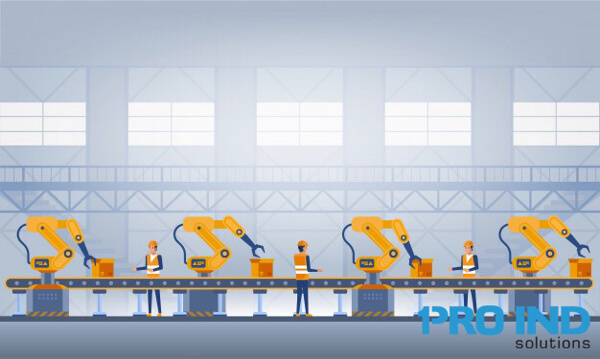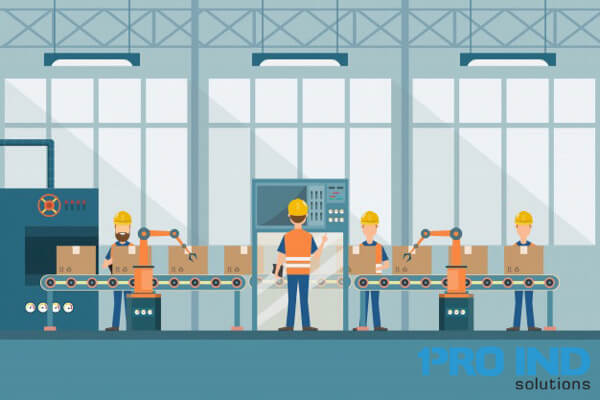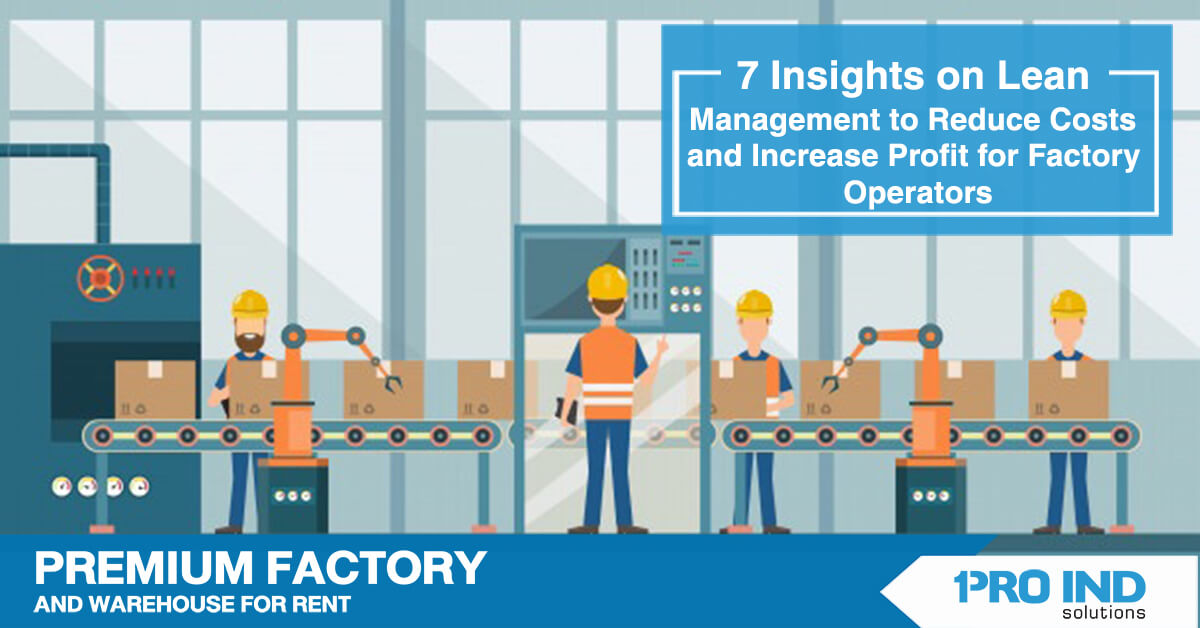7 Insights on Lean Management to Reduce Costs and Increase Profit for Factory Operators
7 Insights on Lean Management to Reduce Costs and Increase Profit for Factory Operators
The lean system (LEAN) is an ideal practice for factory operations. It helps decrease avoidable losses and replace waste to value. It also fosters successful management and helps creates an efficient production process. Implementing this management has benefited small and large companies alike to lower their overall costs. This prominent practice enhances the internal effectiveness of companies.
What is a lean system?
Lean system (LEAN) improves work efficiency in the factory. This concept in the industrial process concentrates on eliminating wasteful and unsalable elements in your work process. Also, it changes wasteful factors either in management or operation to something of value. When applying this system, your activities and productivities would become more efficient and fluid. Hence, your company can be more profitable and competitive in the long run.
How does the lean system help reduce costs (LEAN)?
From the above definition of Lean operation, this concept caters to seven operation areas to mitigate waste and improve profitability. These seven areas (also known as seven waste) can occur due to the following reasons:
1. Losses due to overproduction (Overproduction)
2. Losses due to inventory
3. Losses due to transportation (Transporation)
4. Losses due to motion
5. Losses due to processing
6. Losses due to delay
7. Losses due to wasteful defects
These costs typically occurred in these seven avoidable areas. In this article, we would examine how waste occurs in these areas and illustrate ways to eliminate them.

Lean practice to eliminate seven waste.
1. Losses due to overproduction
In the production process, the traditional ideology is that, since you have already invested in your factory, machinery, salary, and other variable costs, you should produce your products as much as possible. This overproduction is excessive and can hamper your profitability. The production costs per unit may rise due to the excessive resources you have to utilize, plus the oversupply unsellable products can have severe adverse effects on your profitability.
Furthermore, overproduction spoils the firm's performance with numerous problems. For example, the company has to pay extravagantly for work hours and overstaffs. Also, when your company has overstocked products, spoilage can financially hurt your business. Another associated problem from overproduction is that your machines may deteriorate more rapidly than necessary, and you have to face increased maintenance and replacement costs. Thus, you should appropriately allocate your resources and productivity to meet the demand of your market.
2. Losses due to inventory
Another pitfall in your productivity is the loss caused by the surplus inventory. When factory operators place their orders on materials for their manufacturing, they can mistakenly order more than they require. They fall into this pitfall because of two reasons. First, they inaccurately predict their required materials and place their order, which exceeds their use. Second, their suppliers offer them to buy in excess in exchange for discounts. These surplus materials force the factory operators to find extra space for storage, and can quickly become expired and dated.
This loss presents the management with the problem of extra storage space, which obviously can lead to unnecessary expensive costs. Also, they may have to store such materials without knowing when you can use them.
To resolve the waste in this area, you should have a more accurate forecast on your purchasing plan, which should be consistent with your production. Furthermore, you can apply the first-in-first-out regime to subdue the number of surplus materials.
3. Losses due to transportation
Transport losses can occur when your transportation network surpasses the necessary ordinary distances. The transport costs can rise exorbitantly from fuel, labor, maintenance costs for your vehicles.
You can resolve this problem by carefully study transportation routes and select the most appropriate courses. Also, you can improve your shipments by loading your products and materials with maximum efficiency (without compromising delivery time). When you have numerous production locations at various sites, you should meticulously select your positions to lower your transportation costs. These methods can help you decrease your wasteful costs from transportation.
4. Loss due to movement or motion
This type of loss arises from unneedful movements that employees have to engage in their production lines. For example, your factory may unintentionally place objects far away from the manufacturing station. Or, you may set your stored materials inappropriately, and your staffs have to engage in additional bending and lifting activities. These unsuitable locations can slow down your operations as well as cause fatigue and possibly injury to your workers.
You can eliminate this problem by keeping your items close together. It will also help if you thoroughly examine your factory lay-out plans and optimize the interplay of work processes within your factory.

5. Loss due to processing
Redundancy in the production processes is another common problem. The unnecessary steps result in avoidable costs as well as slowing down the work processes. You can resolve this predicament by applying the 5W1H Principles. This principle determines what, when, where, who, why, and how to analyze the work and manage it appropriately.
6. Loss due to delays.
The delays in the manufacturing lines can come from the machines and employees. Such delays unnecessary for production add wasteful costs to your machinery as well as labor costs. Also, these delays can refrain your firm from many opportunities.
You can improve this challenge by prioritizing your production and allocate your labor proportionately. Moreover, you should ensure that your workforce is enough to buffer when a particular unit is absent. With the ability to create work substitution, the training of skilled labor is essential to support the production line continuously.
7. Loss due to defects.
The final wasteful area is from defects. You have to recreate and dispose of these defects prodigally. This problem results in the duplication of work, which drains your time and resources.
You can fortify against this difficulty by improving production standards. Additionally, it would help if you continually monitor the defect rates and find innovative ways to help your production team reduce these defects.
In sum, we hope our article on the Lean method can offer your relevant insights on how you can improve your operation processes. This superior practice can help your operations reduce losses, reduce costs, and increase profitability, and, ultimately, competitiveness for your business.
If you are interested in renting a high-quality factory or warehouses in Thailand, please feel free to contact us anytime. Our properties have complete functions, and they are in excellent locations. Plus, we support our customers with free repair services throughout the leases as well as a full range of customer support services. Our projects have high-security systems with 24-hour security guards, and CCTVs.
Sources:
https://www.leanxacademy.com/single-post/Lean-thinking-8-wastes
http://sc2.kku.ac.th/stat/statweb/images/Eventpic/60/Seminar/01_15_7waste.pdf
You might also like.
- 8 Things to Know About the Revised Thailand Factory Act The new Factory Act came into effect on October 27th, 2019. The government encouraged investment in the industrial sector...
- There are 8 Convincing Advantages of Renting a Factory or a Warehouse. When entrepreneurs establish their businesses or expand their operations, choosing the appropriate factory o...
- 8 Things to Consider in a Factory and Warehouse Rental Contract in Thailand Factory rental and Warehouse rental have become a prominent choice for business people today. Because of...
- Five innovations that PRO IND factories and warehouses for rent use for heat prevention. Global warming is getting worse every year, and Thailand is greatly affected. It has advers...
- There are 5 essential reasons why we should focus on heat prevention inside the factory and warehouse. The hot weather in Thailand does not seem to lessen. From statistics, the te...
- Five reasons examine why the Samut Prakan province did not flood when Thailand's Big Flood in 2011 occurred. When there was a big flood in 2011, Samut Prakan Province was virtual...
- 5 reasons why renting a factory or a warehouse in the Bangna-Trat area is an excellent idea for conducting your business in Thailand. Many people may wonder why they should rent fa...
- 4 Taxes Related to Factory Rentals and Warehouse Rental Currently, many entrepreneurs and business people are renting factories and warehouses for their business operations because...
- 6 Advantages of Setting up your Factory and Warehouse in Samut Prakan When deciding on the area to base your factory or warehouse, surely, Samut Prakarn would come up as one of the...
- 6 Factors in Choosing an Ideal Rental Factory or Warehouse for Your Business. We present six vital factors in determining the right factory or warehouse for your business. Picking ...
- 6 Things to Know about Establishing a GMP Food Factory in Thailand There are strict rules and standards imposed by the government and relevant authorities to adhere to the quality ...
- The Difference between 3-Phase Factory Electricity and 1-Phase Ordinary Electricity What is the difference between 3-phase and 1-phase electrical systems? Which model is suitable f...
- 5 Things you should Know Before Renting your First Warehouse. As your business prospers, you need substantial space to store your products and raw materials. Selecting your first w...
- 10 Features of Excellent Rental Factory and Warehouse Layouts Factory and warehouse layouts are critical to entrepreneurs and business owners' successes in their production. Rentin...
- 6 Advantages of uPVC Windows and Doors for Factory and Warehouse Many customers, who have visited our factory-and-warehouse-rental projects, are delighted with the quality of our d...
- 5 Typical Scams in Factory and Warehouse Rentals Recently, entrepreneurs and business owners are preferring to rent factories and warehouses rather than owning these properties the...
- 3 Benefits of Epoxy Floor Coatings for Factory and Warehouse. Epoxy floor coating is a synthetic rubber that is produced by the chemical reaction between Epoxy and Polyamine combin...
- 10 Effective Ways to Prevent Factory and Warehouse Fires The warehouse and factory buildings are essential to all types of operating businesses. Frequently, they are the businesses...
- 5 Practical Ways to Save Energy in your Rental Factory and Warehouse Modernized factories and warehouses nowadays are undergoing a drastic change: many factories and warehouses are...
- 4 Advantages of PU Roofs for Rental Factory and Warehouse PU Foam insulation is an excellent material for omitting heat transfer into our rental factory and warehouse areas. It com...
- Key Points on Thailand's BOI: Clear Implications for Factory and Warehouse Operators Board of Investment of Thailand (BOI) has the core responsibility in promoting foreign direct i...
- 7 Benefits of Aluminum Composite, and Because of these Reasons, We use it for our Rental Warehouses and Factories. Presently, in the construction materials sector, we frequently no...
- 8 Significant Expenses Related to a Factory and Warehouse Rental in Thailand Renting a factory or a warehouse when you establish your company in a new country is a vital step in yo...
- 8 Questions to Ask When Choosing Warehouse for Rent in Thailand Selecting a suitable warehouse rental is imperative to business success. The current business landscape demands stra...
- Thailand’s Various Rental Warehouse Types and their Purposes This article would distinguish the various warehouse for rent types in Thailand. We can identify a warehouse facility a...
- 4 Safety Dimensions for Factory and Warehouse Operations In successful industrial enterprises, there are many factors that entrepreneurs and plant operators need to consider. Safet...
- Warehouse Management Techniques. How to Practice Warehousing Activities Efficiently for your Business? In manufacturing businesses, warehousing creates substantial financial impact...
- 5 Factors to Consider when Renting a Factory or Warehouse in Thailand Selecting a high-quality rental warehouse or factory is a fundamental step in a successful business establishm...
- 4 Necessary Steps for your Factory and Warehouse Relocation Factory and warehouse rentals have become the current viable choice for business operators because this choice offers ma...
- 5 Things to know about Thailand’s Cold StorageWarehouse for Rent A cold storage warehouse is a warehouse that controls the temperature in the storage area, and the appropriate temp...
- 5 Negotiation Tips for Thailand’s Factory and Warehouse Rental Contracts Selecting a factory and warehouse for rent is an integral part of your business success. In Thailand, succe...
- What are the Similarities and Differences Between the GMP and HACCP Standards in a Factory in Thailand? Two crucial, global standards for food manufacturers are the GMP and HACCP s...
- 7 Things to Know about Establishing a HACCP Manufacturing Facility in Thailand The HACCP system stands for Hazard Analysis and Critical Control Point System. Food production employ...
- 6 Highlights on Thailand’s Factory Clean Rooms Cleanrooms are an essential part of manufacturing sites, which demands high levels of cleanliness. The cleanrooms enable your product...
- 4 Insights on Thailand’s Bonded Warehouse Currently, rental bonded warehouses in Thailand have gained much popularity among business people. Bonded warehouses are especially useful...
- 3 steps to rent a factory and warehouse in Thailand and everything you should know to help you prepare when looking for factories for rent and warehouses for rent. Nowadays, factor...
- 7 crucial factors in choosing a factory and warehouse location in Thailand 7 crucial factors in selecting a rentalwarehouseor factory location in Thailand. This article is relevant...
- 5 things you need to know when choosing a factory for rent and a warehouse for rent in Thailand Quality factories or warehouses for rent can boost the tenant's company image and cr...
- 7 Advantages of Renting Warehouses in Pro Ind Warehouse Park 4 Project Renting a warehouse is a crucial step in managing business inventory, whether for small or large businesses....
- 8 Special Services When Renting a Factory, or Warehouse with Pro Ind Solutions Co., Ltd. At Pro Ind Solutions Co., Ltd., we prioritize the quality of our rental factories, and our ...
- 6 Advantages of Renting an Elevated Warehouse for Rent Choosing an efficient warehouse for rent is a crucial factor that significantly impacts the success of business operations to...



.png)
.png)

